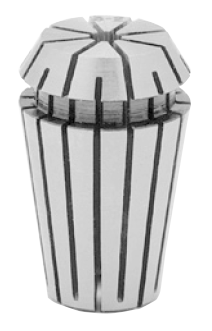How to Choose the Right ER Collet Sizes for Your Tools
When it comes to precision machining, choosing the correct ER collet sizes is essential for accuracy, tool life, and productivity. ER collets are versatile tool-holding systems used across industries like CNC machining, milling, and drilling. They secure cutting tools or workpieces with a perfect grip, ensuring stable and precise operations. But with so many size options available, how do you determine the right ER collet for your tools? This guide breaks it down step by step.
What Is an ER Collet?

An ER collet is a slotted, cylindrical sleeve designed to hold a cutting tool or workpiece in place. The term “ER” stands for “Elastic Rubber,” referring to the collet’s flexibility and clamping range. ER collets are commonly used with collet chucks to provide strong, uniform clamping pressure.
These collets are known for their excellent concentricity, meaning they keep tools centered with minimal runout. This precision translates into smoother cuts, longer tool life, and better surface finishes on machined parts.
Understanding ER Collet Sizes
ER collet sizes are standardized to cover a wide range of tool diameters. The most common series include ER8, ER11, ER16, ER20, ER25, ER32, ER40, and ER50. The number in the series name refers to the collet’s opening diameter in millimeters when fully expanded.
Each collet size can typically hold tools within a 1mm range below its maximum capacity. For example:
- ER16 collet: holds tools from 1mm to 10mm
- ER20 collet: holds tools from 1mm to 13mm
- ER32 collet: holds tools from 2mm to 20mm
The larger the ER collet, the greater the gripping capacity and torque it can handle.
How to Select the Right ER Collet Size
Choosing the proper ER collet size depends on several key factors:
1. Tool Shank Diameter
The most important consideration is the diameter of your tool’s shank. Your ER collet must match this diameter closely for a secure grip. For example, a 10mm tool shank pairs best with an ER16 or ER20 collet, depending on your chuck and machine setup.
Avoid using a collet that’s too large or small for your tool—this can cause runout, vibration, and tool slippage, ultimately affecting precision and safety.
2. Machining Application
The type of machining operation also influences your choice of ER collet sizes.
- Light-duty operations (e.g., engraving, drilling small holes): ER11 or ER16 collets are ideal.
- General milling and drilling: ER20 or ER25 collets work well for moderate loads.
- Heavy-duty machining: ER32, ER40, or ER50 collets are recommended for large tool diameters and higher torque demands.
Matching the collet size to your application ensures stability, accuracy, and consistent performance.
3. Machine Spindle and Collet Chuck Compatibility
Different CNC machines and toolholders support specific collet series. Check your spindle and collet chuck specifications before purchasing. For example, some compact CNC routers are designed for ER11 or ER16 collets, while industrial milling machines may use ER32 or ER40.
Using the correct chuck and collet combination maximizes gripping strength and minimizes tool runout.
4. Material Type and Clamping Force
The hardness of the material you’re machining also matters. Harder materials require stronger clamping pressure to prevent tool deflection. Larger ER collets, such as ER32 or ER40, are better suited for such applications because they provide greater torque resistance and grip stability.
If you’re working with softer materials or smaller tools, a smaller collet like ER11 or ER16 provides sufficient accuracy without excessive pressure.
5. Collet Quality and Maintenance
Even the right ER collet sizes won’t perform well if the collet itself is worn or dirty. Always inspect collets for cracks, rust, or debris before installation. Replace damaged collets immediately—precision depends on their ability to hold tools securely and evenly.
Proper cleaning and regular replacement extend both tool and machine life. High-quality collets made from spring steel or alloy steel offer better elasticity and durability.
Tips for Using ER Collets Effectively
- Clean before use: Dirt or chips can cause misalignment and reduce clamping force.
- Use a torque wrench: Tighten collet nuts according to manufacturer specifications. Over-tightening can damage threads or reduce accuracy.
- Store properly: Keep collets in a dry, organized case to prevent corrosion or deformation.
- Check runout: Regularly measure concentricity using a dial indicator to ensure precision remains within acceptable limits.
By following these simple practices, you’ll get the most out of your ER collet system and maintain consistent machining accuracy.
Common Mistakes to Avoid
- Mixing metric and inch tools: Always verify that your tool shank and collet measurements are in the same unit system.
- Ignoring clamping range: Using a collet outside its rated capacity leads to poor tool holding and potential failure.
- Skipping maintenance: Dirty or damaged collets can cause excessive tool wear and reduce spindle life.
- Avoiding these pitfalls ensures that your machining operations run smoothly and efficiently.
Final Thoughts
Selecting the correct ER collet sizes is crucial for achieving precision, efficiency, and safety in machining operations. By considering tool diameter, machine compatibility, application type, and collet quality, you can ensure optimal performance and longevity of your cutting tools.
Whether you’re running a CNC milling setup or a small workshop, understanding ER collet standards and best practices helps maintain the high precision your projects demand.
Find the perfect ER Collet Sizes for your machining needs with Centaur Precision Tools, Inc. — built for accuracy and reliability.
